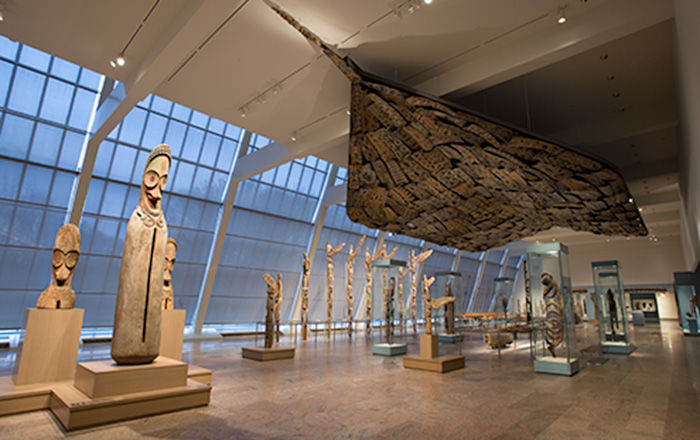Akua 'ba figure
Not on view
The name akua ‘ba (literally, Akua’s child) derives from an Akan legend about a woman named Akua who struggled with infertility. To address her condition, she consulted a priest who advised her to commission the carving of a small wooden child and care for it as she would a living baby, including nursing it and putting it to bed. Despite facing public ridicule with members of her community mockingly calling the figure “akua ‘ba,” her care and dedication to the figure led to a successful pregnancy and the birth of her daughter, which inspired other women to craft similar figurines. Along with conception, akua ‘maa (plural) may be prescribed to prevent complications during pregnancy and childbirth and to avert disease so that the mother and child remain healthy.
The style of this example relates to akua ‘maa carved among the Fante, a prominent confederacy within the broader Akan federation. Distinctive features include an elongated forehead on a rectangular head; a narrow torso represented without arms; thin nose; sweeping, arched eyebrows; and a ringed neck. These features emphasize the feminine ideal for which physical and moral beauty were closely intertwined. For example, wisdom is emphasized through the elongated forehead, and wealth and nourishment depicted through the ringed neck of a well-fed individual. Women would give their akua ‘maa these characteristics in the hope that their daughter would inherit them. This distinctive example features defined hips and legs, which are rarely represented on Fante akua ‘maa. While the elongated rectilinear forehead is a common feature, some Fante artists substitute this element for a carved carved coiffure that might include braids that similarly extend vertically.
This akua ‘ba has a string of yellow beads around its neck. Prior to the late twentieth century, akua ‘maa were one of the most personal items, and the kind of beads used to adorn them could help indicate the owner’s religious affiliation, taste, and wealth. Yellow is used to represent royalty, wealth, glory, and prosperity due to its visual affinities with gold. That color may also symbolize maturity and continuous life. The person who commissioned this figure may have requested the inclusion of yellow beads to indicate their own wealth or in the hopes that their child would live a long, prosperous life.
In order for an akua ‘ba to be an effective fertility tool, the woman who commissioned it from a carver must take it to a priest who then blesses the figure and activates its power through a fertility deity. Like other Akan confederacies, the Fante follow matrilineal descent. As a result of that prominence place of female lineage, the majority of akua ‘maa depict women in the hopes that a daughter will be born.
While akua ‘maa are typically commissioned to address infertility, they may have extended lives among the owner and her descendants. If a daughter was born following the commission of an akua ‘ba, a mother might give the figure to her to play with in the hope that she would assume its nature and beauty as she grew older. Its continued use might also ensure the daughter’s fertility and protect her from malevolent spirits. Alternatively, it could also be enshrined within the mother’s home or with the priest who blessed it.
Ellie Luchini
Roswell L. Gilpatric MuSe Intern, 2025
This image cannot be enlarged, viewed at full screen, or downloaded.
